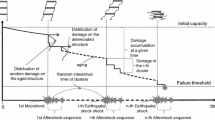Abstract
— All earthquakes are followed by an aftershock sequence. A universal feature of aftershock sequences is that they decay in time according to the modified Omori’s law, a power-law decay. In this paper we consider the applicability of damage mechanics to earthquake aftershocks. The damage variable introduced in damage mechanics quantifies the deviation of a brittle solid from linear elasticity. We draw an analogy between the metastable behavior of a stressed brittle solid and the metastable behavior of a superheated liquid. The nucleation of microcracks is analogous to the nucleation of bubbles in the superheated liquid. In this paper we obtain a solution for the evolution of damage after the instantaneous application of a constant strain to a rod. We show that the subsequent stress relaxation can reproduce the modified Omori’s law. It is argued that the aftershocks themselves cause random fluctuations similar to the thermal fluctuations associated with phase transitions.
Similar content being viewed by others
Author information
Authors and Affiliations
Corresponding author
Additional information
Acknowledgements The authors would like to thank Yehuda Ben-Zion, Bill Klein, William Newman, Leigh Phoenix, John Rundle, and Charlie Sammis for many valuable and stimulating discussions.
Rights and permissions
About this article
Cite this article
Shcherbakov, R., Turcotte, D. A Damage Mechanics Model for Aftershocks. Pure appl. geophys. 161, 2379–2391 (2004). https://doi.org/10.1007/s00024-004-2570-x
Received:
Issue Date:
DOI: https://doi.org/10.1007/s00024-004-2570-x




